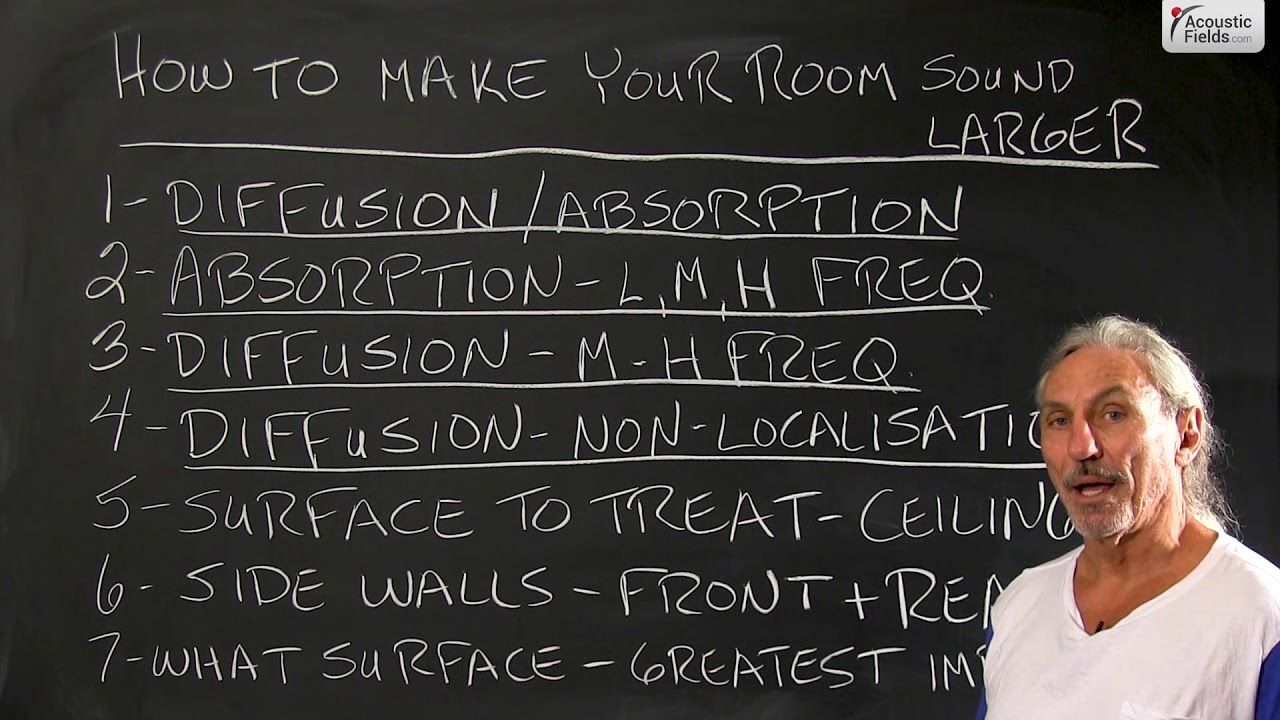Let’s to talk about how to make your room sound larger. Unfortunately most of the rooms I see are very small. People are trying to do a lot in really small rooms. They’re trying to mix, they’re trying to master, they’re trying to record drums, they’re trying to do everything in small rooms. I get it. Real estate is expensive.
With the digital workstations that we have you can do a lot but there really is no substitute for a room that’s of the right size and volume to match the usage. I know we’re all cutting corners with these digital formats but you just can’t beat the sound that you get in a room that’s properly designed and treated for what you’re trying to do. You can’t record drums in a closet. You just can’t. The laws of physics won’t let you and your microphones are better than your ears. So you’re going to hear that small room.
So what are our technologies that we have that are available to us? There’s only two. Contrary to what I see in my inbox every day and the phone calls I get. I get all kinds of names for the two technologies that we have. And there’s only two. Because remember, sound is only, there’s only 3 things that happen to sound: it is diffused, absorbed or reflected.
So we use diffusion and absorption technology to deal with reflections. It’s kind of an inverse flip. So what do we use absorption for? Low, middle and high frequencies, okay? What do we use diffusion for? Middle and high frequencies. We don’t use low frequencies. Low frequencies are reflected. Okay? So we want to keep the domains of the treatment in mind when we’re moving through things.
What diffusion do that’s so magical? It tricks our brain into not localizing the reflection. In my studio in North Hollywood, in California we blindfold people, we put them in a chair, we ask them to estimate the distance from the ceiling to the floor. Our distance from the ceiling to the floor is about 8.5-9 feet in our studio. I never get a guess under 12-13-14 feet.
Now why is that? Why is it that a person who can’t see because he is blindfolded, can’t localize an 8.5-9 foot ceiling and guess it to be 12-13-14? It’s because of diffusion. Diffusion has that real magical property of minimizing the reflection of taking, if you will, a big reflection that comes off of a surface. Well, let’s do it this way. A big reflection that comes off of the surface and breaking it down into a series of smaller reflections. Those smaller reflections versus the big reflection is the process of non-localization. Our hearing mechanism and our brains can’t figure out the distance. We’re real good in an empty room figuring it out. But a room that’s cluttered and full of items and stuff like that, diffusion is really good for that. So selecting the right diffuser to match the distance and the goals that you’re trying to achieve is really critical.
So one of the first surface areas that we treat to make the room sound larger is ceiling. Why is that? Well, it’s usually the smallest of the 3 dimensions. It didn’t used to be the case in older structures but today we have that really low 8-foot ceiling in North-America which is a nightmare. I see a lot of it in Europe, I see a lot of it in Australia, Canada, too. We have that low ceiling.
So that’s a first area that we want. We always want to treat the surface that will have the greatest impact and that’s the smallest distance because that’s the easiest to localize. So we want to treat that surface that’s the shortest of the 3 distances.
Not a big fan of sidewall diffusion, unless it’s a live room, drum room. But for critical listening I like the definition that the proper rates and levels on sidewall reflections get us. And we know from past videos we have 3 sidewall reflections that we have to deal with: primary, secondary and tertiary. Just not the primary that you hear so much about.
So front and rear walls are another area that we focus on for two channel sound, for diffusion because that will take the distance from the front wall to the rear wall reflections and minimize the reflections and open them, open the sound stage up for you through non-localization. So ceiling is a good place to start because it’s usually the shortest dimension and then front and rear walls in most other rooms.
So hope that helps. There is ways to make your room sound larger and the one treatment that can do it better than all the others is diffusion. And quadratic in particular. It’s the only true diffusion that satisfies all the criteria for a diffuse sound field.
—
This is an unedited transcript from our video series from Acoustic Fields. There will be some errors in grammar and sentence structure that occur during this translation process.
For complete understanding and comprehension, please view the video which is included in this text. For any additional information regarding this topic or others relating to room acoustics, please contact us directly at:
P: 520 – 392 – 9486








The discussion on ductwork noise transmission from Acoustic Fields highlights crucial aspects of HVAC system acoustics. The movement of air…
Great build plans. thank you Denis
You must use absorption. Never place a chair against a wall.
A friend and I built several diffusors using these plans and they turned out absolutely beautiful. Very good instructions and…